
Cuckoos are birds in the Cuculidae family, the sole taxon in the order Cuculiformes. The cuckoo family includes the common or European cuckoo, roadrunners, koels, malkohas, couas, coucals, and anis. The coucals and anis are sometimes separated as distinct families, the Centropodidae and Crotophagidae, respectively. The cuckoo order Cuculiformes is one of three that make up the Otidimorphae, the other two being the turacos and the bustards. The family Cuculidae contains 150 species, which are divided into 33 genera.

The cuckoo, common cuckoo, European cuckoo or Eurasian cuckoo is a member of the cuckoo order of birds, Cuculiformes, which includes the roadrunners, the anis and the coucals.

The black-billed cuckoo is a New World species in the Cuculidae (cuckoo) family. The scientific name is from Ancient Greek. The genus name, kokkuzo, means to call like a common cuckoo, and erythropthalmus is from eruthros, "red" and ophthalmos, "eye".
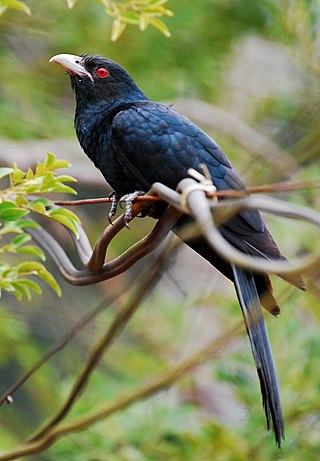
The Asian koel is a member of the cuckoo order of birds, the Cuculiformes. It is found in the Indian Subcontinent, China, and Southeast Asia. It forms a superspecies with the closely related black-billed koels, and Pacific koels which are sometimes treated as subspecies. The Asian koel like many of its related cuckoo kin is a brood parasite that lays its eggs in the nests of crows and other hosts, who raise its young. They are unusual among the cuckoos in being largely frugivorous as adults. The name koel is echoic in origin with several language variants. The bird is a widely used symbol in Indian and Nepali poetry.

Brood parasitism is a subclass of parasitism and phenomenon and behavioural pattern of certain animals, brood parasites, that rely on others to raise their young. The strategy appears among birds, insects and fish. The brood parasite manipulates a host, either of the same or of another species, to raise its young as if it were its own, usually using egg mimicry, with eggs that resemble the host's.

The chestnut sparrow is a species of passerine bird in the sparrow family Passeridae. It is the smallest member of the sparrow family, at about 11 cm (4.3 in) long. The breeding male has deep chestnut plumage and the female and juvenile are coloured a duller grey with some chestnut markings. Like its closest relatives in the genus Passer, the Arabian golden sparrow and the Sudan golden sparrow, it is gregarious and found in arid areas. Ranging through the east of Africa from Darfur in Sudan to Tanzania, it is found in dry savanna, papyrus swamps, and near human habitation. Adults and juveniles both feed mostly on grass seeds, and fly in flocks, often with other species of birds, to find food. It nests in trees, building its own domed nests, and also usurping the more elaborate nests of weavers.
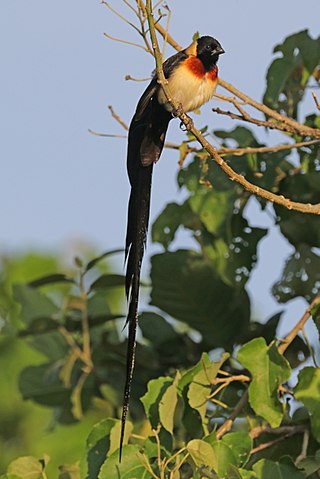
The long-tailed paradise whydah or eastern paradise whydah is from the family Viduidae of the order Passeriformes. They are small passerines with short, stubby bills found across Sub-Saharan Africa. They are mostly granivorous and feed on seeds that have ripen and fall on the ground. The ability to distinguish between males and females is quite difficult unless it is breeding season. During this time, the males molt into breeding plumage where they have one distinctive feature which is their long tail. It can grow up to three times longer than its own body or even more. Usually, the whydahs look like ordinary sparrows with short tails during the non-breeding season. In addition, hybridization can occur with these paradise whydahs. Males are able to mimic songs where females can use that to discover their mate. However, there are some cases where females don't use songs to choose their mate but they use either male characteristics like plumages or they can have a shortage of options with song mimicry. Paradise whydahs are brood parasites. They won't destroy the eggs that are originally there but will lay their own eggs in other songbirds nest. Overall, these whydahs are considered least concerned based on the IUCN Red List of threatened species.

The true koels, Eudynamys, are a genus of cuckoos from Asia, Australia and the Pacific. They are large sexually dimorphic cuckoos that eat fruits and insects and have loud distinctive calls. They are brood parasites, laying their eggs in the nests of other species.

Coccyzus is a genus of cuckoos which occur in the Americas. The genus name is from Ancient Greek kokkuzo, which means to call like a common cuckoo. The genus includes the lizard cuckoos that were formerly included in the genus Saurothera.

Horsfield's bronze cuckoo is a small cuckoo in the family Cuculidae. Its size averages 22g and is distinguished by its green and bronze iridescent colouring on its back and incomplete brown barring from neck to tail. Horsfield's bronze cuckoo can be destiguished from other bronze cuckoos by its white eyebrow and brown eye stripe. The Horsfield's bronze cuckoo is common throughout Australia preferring the drier open woodlands away from forested areas.
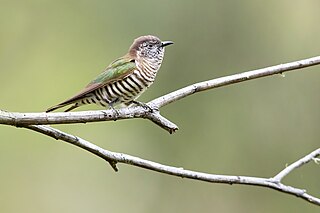
The shining bronze cuckoo is a species of cuckoo in the family Cuculidae, found in Australia, Indonesia, New Caledonia, New Zealand, Papua New Guinea, Solomon Islands, and Vanuatu. It was previously also known as Chalcites lucidus.
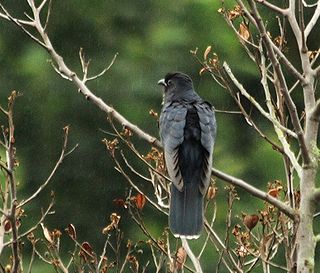
The black cuckoo is a species of cuckoo in the family Cuculidae. The species is distributed widely across sub-Saharan Africa. There are two subspecies. This cuckoo has a very wide range and is quite common so it is classified as a least-concern species by the International Union for Conservation of Nature.

The African cuckoo or African grey cuckoo is a species of cuckoo in the family Cuculidae. It is found in Sub-Saharan Africa where it migrates within the continent, generally arriving and breeding in any one locality during the rainy season. A fairly common bird, the International Union for Conservation of Nature has rated its conservation status as being of "least concern".

The red-chested cuckoo is a species of cuckoo in the family Cuculidae. It is a medium-sized bird found in Africa, south of the Sahara. In Afrikaans, it is known as "Piet-my-vrou", after its call.

The pavonine cuckoo is a Neotropical cuckoo with a long graduated tail and a short crest. It is one of three species of Neotropical cuckoo which are known to be brood parasites.

The Pacific long-tailed cuckoo, also known as the long-tailed cuckoo, long-tailed koel, sparrow hawk, home owl, screecher, screamer or koekoeā in Māori, is a species of the Cuculidae bird family. It is a migratory bird that spends spring and summer in New Zealand, its only breeding place, and spends winter in the Pacific islands. It is a brood parasite, laying its eggs in the nests of other bird species and leaving them to raise its chicks.
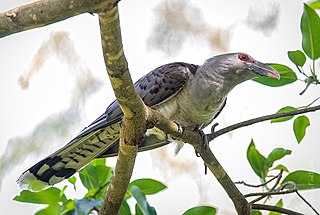
The channel-billed cuckoo is a species of cuckoo in the family Cuculidae. It is monotypic within the genus Scythrops. The species is the largest brood parasite in the world, and the largest cuckoo.

The cuckoo-finch, also known as the parasitic weaver or cuckoo weaver, is a small passerine bird now placed in the family Viduidae with the indigobirds and whydahs. It occurs in grassland in Africa south of the Sahara. The male is mainly yellow and green while the female is buff with dark streaks. They lay their eggs in the nests of other birds.

Egg tossing or egg destruction is a behavior observed in some species of birds where one individual removes an egg from the communal nest. This is related to infanticide, where parents kill their own or other's offspring. Egg tossing is observed in avian species, most commonly females, who are involved with cooperative breeding or brood parasitism. Among colonial non-co-nesting birds, egg-tossing is observed to be performed by an individual of the same species, and, in the case of brood parasites, this behavior is done by either the same or different species. The behavior of egg tossing offers its advantages and disadvantages to both the actor and recipient.
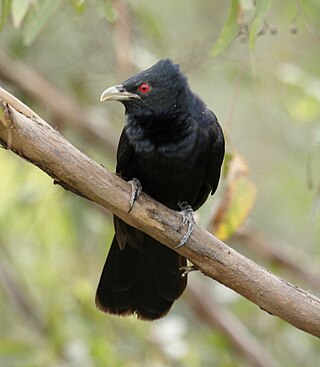
The Pacific koel, also known as the eastern koel or formerly common koel, is a species of cuckoo in the family Cuculidae. In Australia, it is colloquially known as the rainbird or stormbird, as its call is usually more prevalent before or during stormy weather.






















